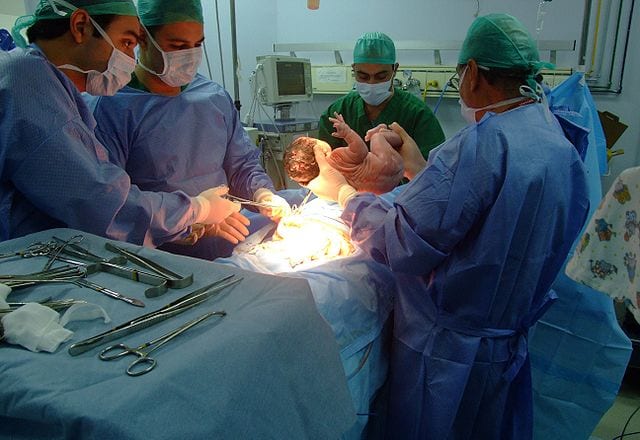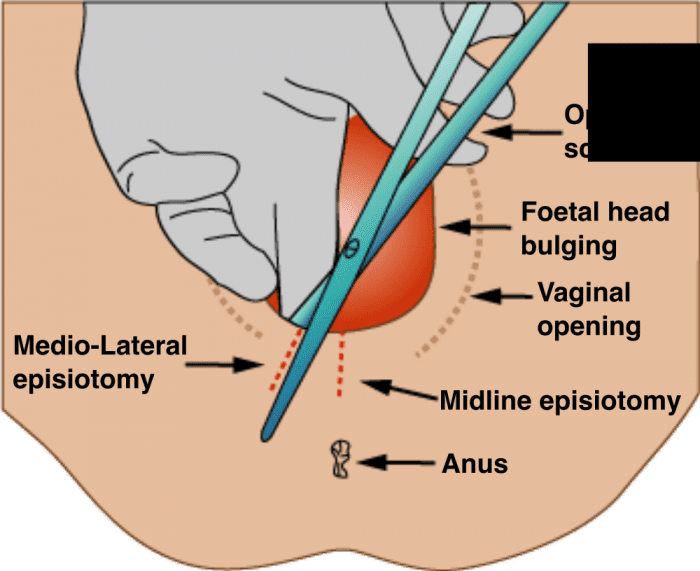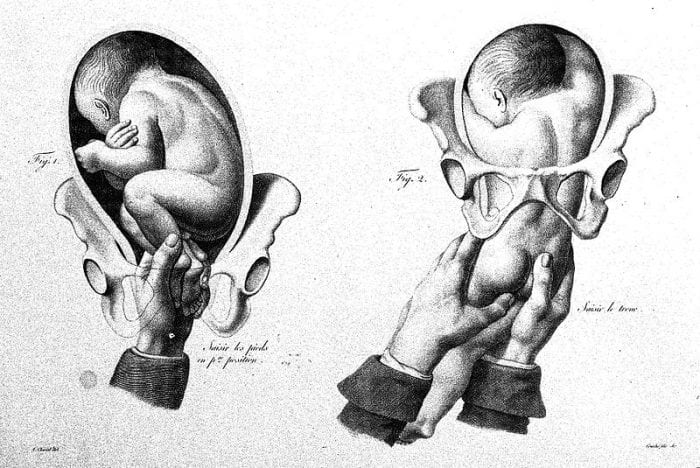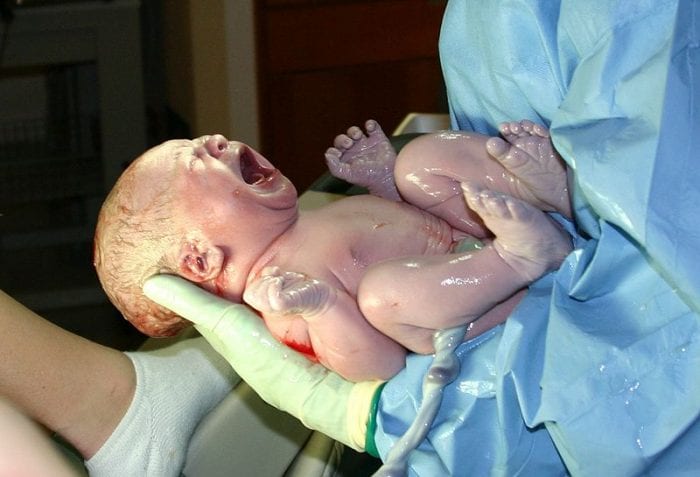With about 7.6 billion world population, 49% comprises women or about 3.7 billion.
As per Sound Vision, there are about 2 billion mothers in the world, and about 4.3 babies born every second.
Imagine how many minds have been thrilled or maybe tormented by giving birth and the injuries or scars they might obtain through episiotomy, as not all deliveries or childbirths are the same.
In this article, we explore the reality of episiotomy and gain a deeper understanding of it.

Source: commons.wikimedia.org
It could depend on the baby’s size and the mother’s body.
Some smoothly experience childbirth, according to a healthcare provider, while some suffer a traumatic moment to the point of near death. Read on to find out more of the research we’ve compiled for you.
What Is Episiotomy?
In obstetrics and gynecology, an episiotomy is the artificial widening or cutting of the area between the vagina and the anus using surgical scissors or a scalpel. This area is called the perineum. This is done to accommodate the size of the head or when the baby is breech to avoid perineal tears. The midwife or healthcare provider slits the perineum or the area between the vagina and the anus to create a wider opening for the baby.

Source: commons.wikimedia.org
It was in 1742 when Sir Fielding Ould first performed episiotomy as he described the head to be stuck in the perineum and could not come out. However, the healthcare provider clearly stated that the surgical procedure should only be performed as a last resort or in cases of emergency where the lives of either the mother or the baby are at risk.
The Two Types Of Episiotomy
Midline Or Median Incision
Midline incision or median incision is a vertical slit or cut. Not just one healthcare provider said this is the easiest to restore, but the downside of this is there is a higher chance of cutting down into the anus.
Mediolateral Incision
A mediolateral incision is an angled or diagonal slit or cut. A mediolateral episiotomy could be more painful, but it would avoid extending the cut down into the anus.
Common Causes Of Episiotomy

Source: commons.wikimedia.org
- Healthcare provider sees there is a possibility of a vaginal tear which is 95% of the time, especially for new moms
- The baby is large and the vaginal opening is small
- The baby doesn’t get enough oxygen
- Baby in a breech position
- Baby’s head is in an incorrect position or tilted to the side
- Baby’s life or yours is at risk; emergency delivery is needed
- Having twins
- Previous pelvic surgery
What Are The Complications Of Having Episiotomy?
- There is a risk of infection after the procedure
- The risk of inflammation after the procedure
- The risk of hematoma or the accumulation of blood in the area
- The risk of bleeding after the procedure
- Many become afraid of having sexual intercourse after the procedure
- The pain of having sexual intercourse after the procedure
Aftercare Tips For Episiotomy:

Source: pxhere.com
- Antibiotics to prevent infections
- Pain relievers to reduce pain and discomfort
- Stool softener to aid in smooth bowel movements
- Medicated pads
- Bidet instead of toilet paper when cleaning
- Squirt bottle instead of solid soaps
- Application of cold packs to numb the perineum area
When To Call The Doctor:
- Foul-smelling discharge from the site
- Bleeding from the site
- Experience perineal pain
- Signs of infection such as fever, pain, or swelling at the incision site that does not improve
- Pain medications do not seem to take effect
- Have trouble controlling your bowels or bladder

Episiotomy sounds to be a nightmare, a part of the magical moment of childbirth which most mothers prefer not to talk about. If you are about to give birth and do not want to have the cut, you should choose a doctor who doesn’t perform episiotomies.
Also, it would help if you make your objection clear. Labor and childbirth are already traumatically painful as they are. So when there is a way you can avoid experiencing further suffering brought by episiotomy, make the decision to prevent the unnecessary cut.
Takeaway
Frequently Asked Questions (FAQs):
What Is An Episiotomy?
An episiotomy is an incision in the area between the vagina and anal sphincter. Routine episiotomies expand the opening of the vagina to prevent the vaginal tissue from going through natural tearing during the delivery. There are different levels of possible tearing, with fourth degree tearing being the most extreme. Read further here: https://www.hopkinsmedicine.org/health/treatment-tests-and-therapies/episiotomy
Is It Okay To Undergo This?
American healthcare providers widely believe that an episiotomy heals better than a natural or spontaneous perineal tear. However, there are some instances when it may cause more problems than it prevents, particularly if you need more than a midline incision. You have to talk about it with your healthcare provider during the second stage of your prenatal visits.
How Do You Care For This?
You can use pain relievers for that. These include ibuprofen, medicated creams, and local anesthetic sprays, to ease the pain from an episiotomy. Your healthcare provider will discuss different techniques to help you heal as soon as possible.
Can An Episiotomy Tear Again?
It may take time to repair the tears in surgery, and it may take several months to recover from it fully. But a lot of women who have another vaginal delivery will not have a severe tear again.
Can Episiotomy Stitches Reopen?
Sometimes episiotomy stitches do not just come undone, according to a healthcare provider. But occasionally pressure or an infection on the stitches can cause the sutures to break down. Thus, it leaves an open or gaping wound.
What Are The Risks Of An Episiotomy?
A healthcare provider said that the higher risk of vaginal opening issues include tearing, bleeding, swelling, infection, and pain during sex.
What’s The Fastest Way To Heal An Episiotomy?
You can cure midline episiotomy or midline incision by using ice pack and sitz baths on your vaginal opening, as well as changing your pads every 2 to 4 hours. Just keep the area of the stitches dry and clean.
Why Would Doctors Do Episiotomy?
You need an episiotomy to prevent more extensive vaginal tears during a woman’s childbirth (vaginal birth or normal labor, that is). Routine episiotomies also help preserve the connective and muscular tissue support of the pelvic floor and avoid fetal distress and shoulder dystocia in the second stage of labor.
How Do You Poop After This Procedure?
One of the perineal techniques is to make it less painful on the vaginal opening stitches or natural tear by using a sanitary pad that is folded. Pressed against your vagina or perineal skin while straining with your anal sphincter muscle. Wipe from front to back to ensure your stitches are clean.
What Should You NOT Do After The Procedure?
First, patients should abstain from sexual intercourse until the episiotomy completely heals. That’s surgical incision does not help on reducing perineal trauma on your vaginal tissues and sphincter muscle, so you shouldn’t stress it out further to ease soreness and reduce swelling and higher risk of opening up your stitches. Also, avoid douching and using tampons.
Can These Stitches Get Infected?
Infection is possible as with all surgical procedures. If you experience severe pain at the incision site, and there’s redness and swelling around the stitches, call your doctor immediately.
How Long Will It Take For The Scar To Heal?
Usually, it is within ten days. It shouldn’t take more than a month.
Do The Stitches Bleed?
Yes, the episiotomy incision has a high risk of bleeding quite a bit at first. But it should stop once your doctor closes the wound with sutures.
Is It Normal For The Scars To Hurt?
Yes, scar tissue can develop after episiotomy and has a high risk of causing intense pain if it gets irritated, especially if you have fresh episiotomy incisions, even if you take over-the-counter medication.
When Can I Take A Bath After The Procedure?
What Is This And When Is It Performed During A Vaginal Birth?
How Is This Incision Different From Other Types Used In Childbirth?
What Are The Risks And Benefits Of Having An Incision During A Vaginal Birth?
Last Updated on May 9, 2023 by Lisette Lao
DISCLAIMER (IMPORTANT): This information (including all text, images, audio, or other formats on FamilyHype.com) is not intended to be a substitute for informed professional advice, diagnosis, endorsement or treatment. You should not take any action or avoid taking action without consulting a qualified professional. Always seek the advice of your physician or other qualified health provider with any questions about medical conditions. Do not disregard professional medical advice or delay seeking advice or treatment because of something you have read here a FamilyHype.com.